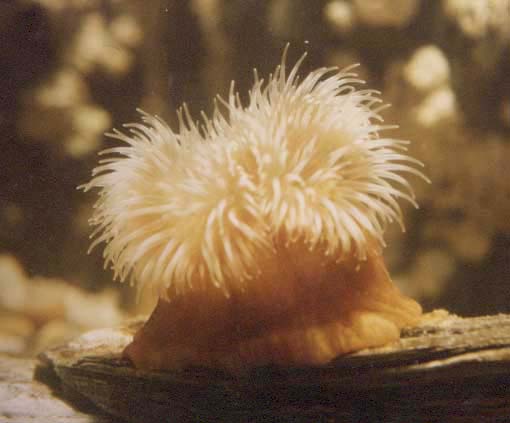
April |
|||||||||||||
|
If the warmer weather coincides with the low spring tides a visit to a rocky shore can be rewarding during April. Small pools will contain the smaller prawns, rock pool fish, sea anemones and the first fry of the year. The more delicate red and green seaweeds will begin to decorate the pools on sheltered shores. These annual algae can provide an attractive border to pools on the sculptured limestone coasts of Dorset. On more exposed locations, hydroids, looking like miniature sea-firs grow on rocks, shells and seaweeds. Although they look like plants, they are colonial animals that consist of branches with microscopic polyps. The polyps behave like tiny sea anemones with stinging cells to capture the even smaller life in the plankton. INHOSPITABLE SHORES In winter a rocky shore can be a rather desperate and drab place, and even in April it will only attract the very keen rockpooler. A lot depends on the location; on the most hospitable shores a sandstone platform will take the explorer down to the most interesting pools at the low spring tide mark. On other shores the visitor will have to scramble down the remains of a crumbling cliff to be greeted with a mass of broken chalk and seaweed strewn boulders. The attractiveness of the shore at first sight does not give an immediate
indication of its variety of fauna. Loose rocks are often very rich in
small fish because they provide a place for the fish to hide under when
the tide recedes. Crabs also need the protection of rocks or holes to creep
into.
COLOUR One of the reasons that 'Native Marine Aquaria' are not so popular as
the tropical hobby is because the fish and invertebrates lack the bright
colours of their reef cousins. There is no doubt this is true, but there
are lots of colourful life on the British coasts and when collected together
in an aquarium the final display can certainly rival a tropical marine
aquarium for interest and attractiveness, with colours that are subtle
and less garish.
On British shores the most colourful animals are the sea anemones
that will attach themselves to the underside of rocks and often hide in
the most inaccessible places. In a few limestone areas, colourful varieties
of the Daisy Anemone, Cereus pedunculatus,
form a carpet over the walls of deep pools. These anemones have long columns
and when the tentacles are touched by the legs of a wandering prawn or
the probing fingers of a rockpooler, they will quickly retract into a rock
fissure.
SEA ANEMONES Every marine aquarist will know that sea anemones are not plants but animals that use their tentacles to capture minute animals of the plankton and prey up to the size of small fish and crabs. They belong to the phylum (major evolutionary group) of invertebrates
called the Cnidaria. The name comes from the
cells called cnidae which are present in all species in this group. The
cnidae contain the stinging cells of which the nematocysts are the commonest
type. The nematocysts can only be seen under a powerful microscope and
their mechanism for working is one of the fastest actions in the whole
of the animal kingdom. The fluid-filled capsule called the nematocyst everts
and forces the filament to discharge and eject venom into the prey. In
sea anemones the tentacles contain the stinging cells and in some species
they are powerful enough to kill small fish and prawns.
It is important that the aquarist knows about this mechanism because not all anemones are easy to feed. Most rock pool species will happily take crushed or whole pieces of mussel or bottled invertebrate food, using their tentacles to manipulate their food towards the mouth which is the solitary opening leading to the gastric cavity called the coelenteron. However, a worldwide species with the apt name of Plumose Anemone*, Metridium senile, will sometimes refuse to feed on large items of organic matter in captivity. The solution is knowing how to activate the nematocysts. In the wild,
the Plumose Anemone inhabits 'high energy habitats' where the powerful
tides and currents bring the sea rich in plankton to the sessile colonies.
The anemone consumes mostly microscopic prey caught in the thin feathery
concentric circles of tentacles. At the times of maximum current large
items of dead prey become trapped against the colonies, and the anemone
is able to manoeuvre this food to its mouth using 'catch tentacles' (enlarged
tentacles). The trick is to mimic the conditions in the wild. This can
be done in two ways: by introducing fresh real sea water with its plankton
content, or by putting a plentiful supply of newly hatched brine shrimp
in the aquarium. Ninety per cent of the time the Plumose Anemone can be
tricked into consuming large fragments of boiled mussel or similar foods.
ZOOXANTHELLAE Another problem in keeping sea anemones is maintaining anemones that
contain zooxanthellae algae within their tissues. The chlorophyll in the
algae stains the anemone a vivid green. If the algae dies the anemone gradually
loses its green hue. This is seen most often in the Snakelocks
Anemone, Anemonia viridis, which is very common on the southern
and western coast of the British Isles.
Although this anemone will consume particle food the zooxanthellae appear
to be essential for its long term survival. It is difficult to mimic the
required summer light levels of about 4000 Lux indoors, but some success
has been achieved in outdoor aquaria with frequent renewals of real sea
water.
Notes: * Known as the White-plumed, or Frilled, Anemone in the USA.
|
|||||||||||||


